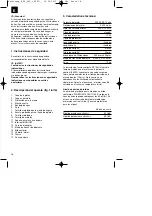
12
GB
until the disk guard (3) can only just move freely.
Then secure the connection with the lock washer (g)
on the thread of the knurled screw (9).
6.2 RCD plug (Fig. 18)
Connect the RCD plug (21) to the power supply.
Press the reset button (22) and the control lamp (23)
will begin to shine. Press the test button (24) to
check the function of the RCD plug. If everything is
working properly the control lamp (23) will go out and
the contact to the power supply will be interrupted.
The RCD plug triggers at a fault current of 10 mA.
Defective RCD plugs must be replaced by a qualified
electrician. Press the reset key (22) again in order to
be able to start up the machine.
6.3 Changing the diamond cutting wheel (Fig. 14)
To replace the wheel when worn, proceed as follows:
Pull out the power plug first.
Take out the water trough (5).
Remove the side cover (17).
Apply an 8 mm counterholder to block the motor
shaft.
Unscrew the lock nut (18) on the wheel flange
(16) with a 19 mm wrench.
Clean the wheel flange thoroughly once the
wheel has been removed.
Take out the worn diamond cutting wheel (15)
and fit the new one to the flange, then fit the
outer flange (16) and tighten with the nut (18).
Fasten the side cover (17) again.
Important! Check that the diamond wheel (4)
rotates in the correct direction!
6.4 Adjusting the top wheel guard Fig. 15)
Insert the splitter (19) through the table and into
the holder (11) from above and fasten with the
screws (20).
Move the wheel guard to approximately 5 mm
above the tile you wish to cut. Lock the wheel
guard (3) in position with the knurled screw (9)
as shown in Fig. 15.
Important!
The machine is fitted with a cutting
wheel with a non-segmented edge.
7. Operation
7.1 Even cutting (Fig. 1/16)
Set the cutting width with the parallel stop (2)
and lock in position with the thumb screws (10).
The width of the workpiece can be read on the
scale.
Fig. 16 shows the correct position for your hands
during even cutting. The rate of advance must
not exceed the cutting capacity of the wheel.
This is to make sure that no material comes off,
as this may cause accidents or injuries.
Important! Keep a constant check on the water
level
7.2 Making 45° miter cuts (jolly cuts) (Fig. 17)
Position the table as shown in Fig. 17 and lock in
position with the handles (7). Position the tile
with the glazed side on the work surface and
make sure that the diamond wheel does not
touch the glaze on the tile. Correct the cutting
guiding position if necessary.
Fig. 17 shows the correct position for your hands
during miter cutting to 45°. The right hand holds
the workpiece in contact with the diamond wheel
while the left hand pushes the workpiece
forward. The rate of advance must not exceed
the cutting capacity of the wheel. This is to make
sure that no material comes off, as this may
cause accidents or injuries.
8. Cleaning, maintenance and ordering
of spare parts
Always pull out the mains power plug before starting
any cleaning work.
8.1 Cleaning
Keep all safety devices, air vents and the motor
housing free of dirt and dust as far as possible.
Wipe the equipment with a clean cloth or blow it
with compressed air at low pressure.
We recommend that you clean the device
immediately each time you have finished using it.
Clean the equipment regularly with a moist cloth
and some soft soap. Do not use cleaning agents
or solvents; these could attack the plastic parts
of the equipment.
8.2 Maintenance
There are no parts inside the equipment which
require additional maintenance.
8.3 Ordering replacement parts
Please quote the following data when ordering
replacement parts:
Type of machine
Article number of the machine
Identification number of the machine
Replacement part number of the part required
For our latest prices and information please go to
www.isc-gmbh.info
Anleitung_H_FS_920_1_SPK7:_ 10.02.2011 7:54 Uhr Seite 12













































